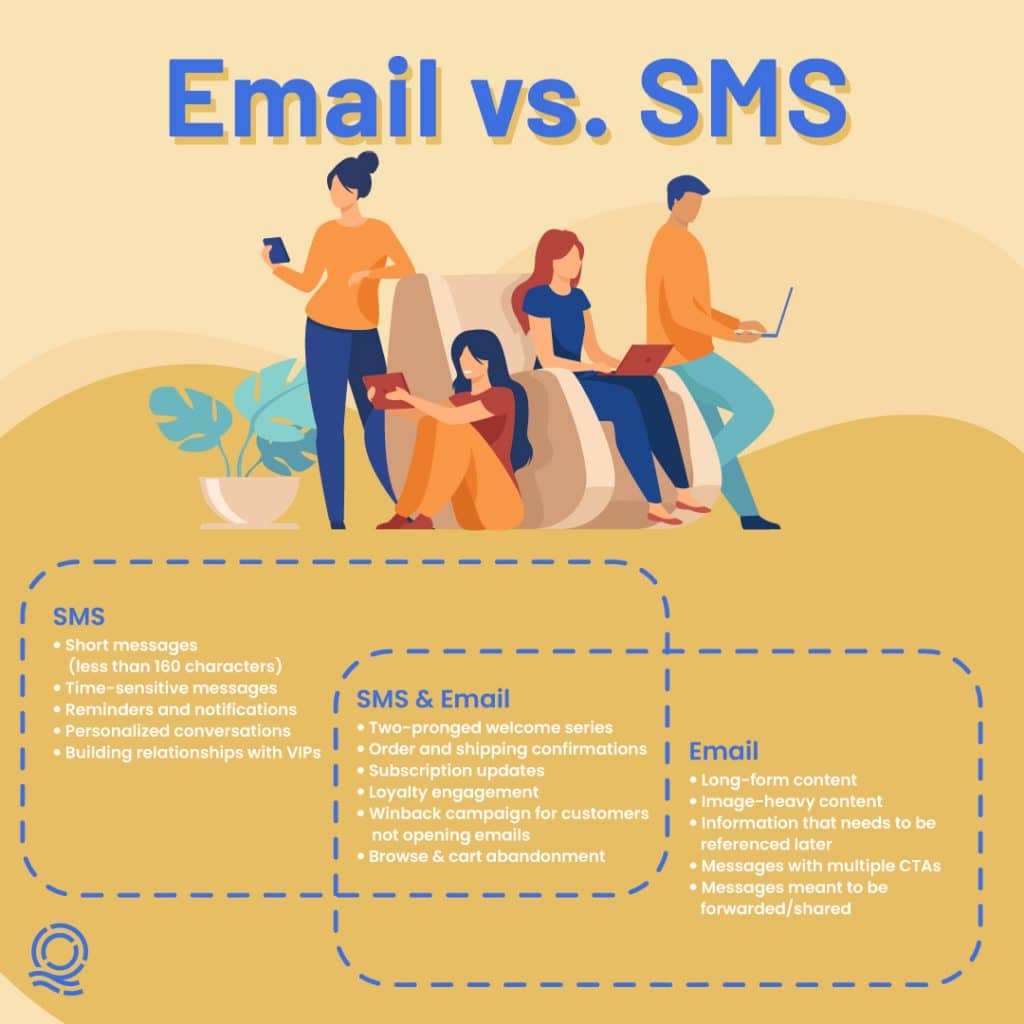For years, email was pretty much the only viable marketing channel for ecommerce stores. If you wanted to directly promote a product, you sent an email. If you wanted to send a special discount to VIP customers, you sent an email. If you wanted to send a shipping notification… you get the picture.
While email marketing is still an essential marketing channel for any competent online store, SMS has quickly become the talk of the town among savvy marketers.
Text messaging has become ubiquitous and everyone spends countless hours every day on their phones. And people aren’t just chatting with their friends. The average person is on their smartphone every day browsing social media, sending and receiving messages, and SHOPPING. In fact, smartphones are the number one device used for shopping in North America.
You know that old saying in marketing, “Meet your customers where they are?” Well, your customers are on their mobile phones and it’s time to meet them there.
But just because SMS is quickly changing the ecommerce landscape doesn’t mean that you should abandon your email marketing strategy. In reality, it means that you should adapt your lifecycle marketing strategy to include email AND SMS.
In this article, we’re going to look at email vs. SMS, including comparisons, benefits and use cases for both
The Benefits of SMS
Based on metrics alone, SMS makes email marketing look like it should go the way of the dinosaur.
Some key metrics to consider are open rates and click-through rates. SMS has over a 98% open rate compared to email’s 20%. That means people are almost 5x more likely to open their SMS messages than their emails. Once opened, the likelihood of your customer clicking through is around 17% for SMS and 2.9% for email. When most of the world has a cell phone, it’s no wonder that SMS generates more engagement.
SMS can also be considered a more accessible channel. While iPhones and Androids are commonplace in most major cities, nearly half of all cell phone users do not own phones capable of handling advanced mobile marketing. An email containing a visually stunning promo may get saved to be opened at home, while a quick text about a new product could be seen immediately by someone with a flip phone.
Extensive data supports the use and effectiveness of SMS marketing. Given how effectively it will grab a customer’s attention, there are some purposes where it is most suitable.
SMS Use Cases
- Time-sensitive messages: If there is a time window in which a customer needs to complete something, sending a text is the answer.
- Short reminders and notifications: Think tracking updates and appointment reminders.
- Personalized conversations: Being able to ask for help or updates via text.
- Cultivating relationships: Like sending personalized messages or tailored ads.
Best Practices for SMS
- Ask for permission: It’s critical to ask customers to opt-in through an online form or by using a message with a keyword or phrase. Sending unsolicited messages will earn a number block.
- Send messages during appropriate hours: No one likes waking up to a notification in the middle of the night. Ensuring that texts are received during normal business hours prevents customers from unsubscribing.
- Stay succinct: Messages should be clear and concise. Focus on keywords and calls-to-action.
- Know when to stop: Don’t neglect other channels of communication. There is nothing more aggravating than a phone buzzing non-stop with new text notifications.
With such an effective channel like SMS, why bother with email at all? The limit of the standard text is only 160 characters. For long-form, email is optimal.

The Benefits of Email
The beauty of email is its versatility.
Sometimes complex and detailed information has to be conveyed in business communications. The allotment for lengthy writing is a top benefit of email. Although there is value in concise communication, long-form emails are sometimes necessary.
Another benefit of email is that it can be easier to grow your email list than your SMS subscriber list. Some people are still wary of opting in to receive text messages, but most people are comfortable with providing their information to receive marketing emails.
Though you may fear your emails becoming lost in the spam folder, a good email marketing agency knows how to optimize deliverability. At the end of the day, a 20% open rate is still far from zero.
While it’s true that texting generates more urgency, that same urgency can also annoy some customers. Some prioritize replying to their texts immediately and will not want to be bothered with superfluous notifications. Email campaigns are generally considered a comfortable, less invasive form of communication. It can do anything SMS can and more.
Email also allows space to be creative. Captivating long-form copy and high-resolution images can work together to show off a new product. Account confirmations, policy updates, monthly newsletters… with email, anything is possible. Though the sky is the limit, certain content is optimum.
Email Use Cases
- Long-form content: Share the story about your brand here.
- Image-heavy content: Pictures are worth a thousand words in a carefully crafted email.
- Information to be saved for later: Signed agreements and forms should be attachments.
- Large attachments: PDFs don’t translate well via SMS.
- Content with multiple calls-to-action: If multiple releases or promotions are happening at the same time, email is much more effective.
- Content designed to be shared: Like an email to be forwarded to a friend for a discount.
Best Practice for Email
- Write concise subject lines: Email accounts and mobile devices often cut off any subject lines any more than 30 to 50 characters. The subject line should create a sense of urgency while giving readers some indication of what to expect.
- Use incentives to increase open rates: Discounts and promotions mentioned in the subject line will significantly boost an email’s open rate.
- Test emails before sending: Send the email to a friend or colleague. If they can’t identify the call-to-action within 5 seconds, look it over again.
- Keep it simple and clean: Email will allow you to include multiple CTAs, images and attachments. Usually, less is more.

The Benefits of SMS & Email Combined
As you can tell, both SMS and email are cost-effective communication channels. SMS creates instant awareness, and email is the workhorse that can do everything else to keep your business communications flowing.
That means your best option is to combine and conquer.
There are many situations where communication can be more effective when SMS and email when used in tandem.
Say a new product is about to be launched. Using a text campaign to notify subscribers about the pre-sales event will get the word out quickly. Following up with an email containing details and images about the product provides clarity and encourages customers to follow through.
Using both can also help with customer management, for example:
- Sending shipping notifications via text and detailed invoices via email.
- Offering product giveaways via text and following up with terms via email.
- Notifying about changes in terms and conditions via text and sending updated attachments via email.
Are you trying to decide between SMS or email? Think about it in terms of importance and time. The more imperative it is that the customer sees your message quickly, the more likely it is that you need to send a text. If you have too much detail to convey or need to send an attachment, follow up your text notification with an email. Try to use a combination of both when at all possible.
If you’re still struggling to decide, use email marketing and SMS in conjunction to really hit the message home.
Email and SMS can work together to create a seamless communication experience for customers. Maximize the return on investment for marketing campaigns and increase customer retention by using them effectively and complementary to one another.
